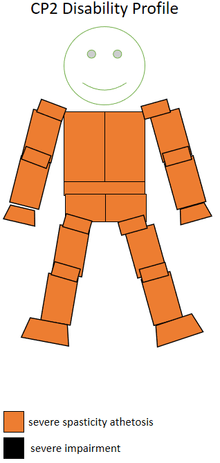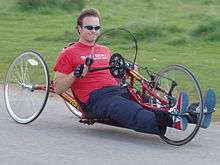H1 (classification)
H1 is a para-cycling classification. It includes people with a number of disability types including spinal cord injuries an cerebral palsy. Handcycles that can be used by people in races include the AP2 recumbent and AP3 recumbent. The classification competes at the Paralympic Games and has international rankings done by the UCI.
Definition

Union Cycliste Internationale (UCI) defines H1[1] as:
- Tetraplegia C6 or above and severe athetosis/ataxia/dystonia[1]
- Tetraplegic with impairments corresponding to a complete cervical lesion at C6 or above[1]
- Complete loss of trunk stability and lower limb function[1]
- Limited extension of the elbow with a muscle score of 6 (total of both tri- ceps)[1]
- Limited handgrip[1]
- Non-spinal cord injury, but functional ability profile equivalent to sport class H 1.1[1]
- Impaired sympathetic nerve system[1]
- Recumbent position in handbike mandatory (AP-bikes)[1]
- Severe athetosis/ataxia/dystonia and elbow extension limitation[1]
- Asymmetric or symmetric quadriplegia with at least grade 3 spasticity in upper limbs and lower limbs.[1]
The UCI recommends this be coded as MH1 or WH1.[2]
Disability groups

People with cerebral palsy are one of the classes eligible to compete in this class, including CP/ISRA CP2 classified cyclists.[3] All CP2 cyclists are required to wear a helmet, with a special color used to designate their class.[4] Their helmet color is red.[5][6]
CP2 cyclists tend to use electric wheelchairs in everyday life. They may have controlled shakes and twitches. This bodily activity can spike their metabolic rate.[7][8][9][4] They can operate a manual wheelchair but this is restricted because of motor control issues.[8] Functional control issues effect all or most of their limbs.[10][9][11] When participating in sport, CP2 competitors tend to have low energy expenditure.[7]
The cycle

This classification can use an AP2 recumbent, which is a competition cycle that is reclined at 30 degrees and has a rigid frame. This classification can also use an AP3 hand cycle which is inclined at 0 degrees and is reclined on a rigid competition frame.[12]
Classification history
Cycling first became a Paralympic sport at the 1988 Summer Paralympics.[13] In September 2006, governance for para-cycling passed from the International Paralympic Committee's International Cycling Committee to UCI at a meeting in Switzerland. When this happened, the responsibility of classifying the sport also changed.[14]
At the Paralympic Games
For the 2016 Summer Paralympics in Rio, the International Paralympic Committee had a zero classification at the Games policy. This policy was put into place in 2014, with the goal of avoiding last minute changes in classes that would negatively impact athlete training preparations. All competitors needed to be internationally classified with their classification status confirmed prior to the Games, with exceptions to this policy being dealt with on a case by case basis.[15]
Rankings
The following are the men's rankings for this classification As of June 2012:[16]
| Rank | Name | Nation | Points | References |
|---|---|---|---|---|
| 1 (1) | Rodolph Cecillon | France | 67 | [16] |
| 2 (-) | Mark Rohan | Ireland | 63 | [16] |
| 3 (-) | Yakov Lion | Israel | 63 | [16] |
| 4 (3) | Christoph Hindricq | Belgium | 59 | [16] |
| 5 (-) | Wolfgang Schattauer | Austria | 54 | [16] |
| 6 (5) | Patrick Pascal | France | 53 | [16] |
| 7 (-) | Robert LabbÉ | Canada | 52 | [16] |
| 8 (2) | Alain Quittet | France | 47 | [16] |
| 9 (-) | Tobias Fankhauser | Switzerland | 40 | [16] |
| 10 (4) | Christophe Marchal | France | 18 | [16] |
| 11 (-) | Martin KovÁr | Czech Republic | 17 | [16] |
| 12 (-) | Christoph Etzlstorfer | Austria | 17 | [16] |
| 13 (-) | Pavel FoltÝn | Czech Republic | 6 | [16] |
| 13 (-) | Omar Rizzato | Italy | 6 | [16] |
| 15 (-) | Torben BrÖer | Germany | 5 | [16] |
| 16 (-) | Attilio Cortello | Italy | 4 | [16] |
| 17 (-) | Ivano Da Canal | Italy | 3 | [16] |
| 17 (-) | Federico Villa | Italy | 3 | [16] |
Becoming classified
Classification is handled by Union Cycliste Internationale.[17] Classification for the UCI Para-Cycling World Championships is completed by at least two classification panels. Members of the classification panel must not have a relationship with the cyclist and must not be involved in the World Championships in any other role than as classifier.[18] In national competitions, the classification is handled by the national cycling federation.[18] Classification often has three components: physical, technical and observation assessment.[18]
References
- "UCI Cycling Regulations - Para cycling" (PDF). Union Cycliste International website. Retrieved 2 June 2016.
- "UCI Para-cycling Classification Guide". UCI. 17 April 2012. p. 4.
- "Classification Made Easy" (PDF). Sportability British Columbia. Sportability British Columbia. July 2011. Retrieved July 23, 2016.
- Hutson, Michael; Speed, Cathy (2011-03-17). Sports Injuries. OUP Oxford. ISBN 9780199533909.
- Hernández García, Jose Ignacio; Vecino, Jorge Manrique; Koszegi, Melinda; Marto, Anabela. "PROGRAMA LEONARDO DA VINCI, TRAINING SPORT ASSISTANTS FOR THE DISABLED" (PDF). Programa Leonardo da Vinci. European Union. Archived from the original (PDF) on August 16, 2016. Retrieved July 24, 2016.
- "CAPACITÀ PER LO SPORT`, FORMAZIONE DEGLI OPERATORI SPORTIVI SPECIALIZZATI PER PERSONE CON DISABILITÀ" (PDF). Programa Leonardo da Vinci (in Italian). European Union. September 2006. Archived from the original (PDF) on August 17, 2016. Retrieved July 24, 2016.
- Broad, Elizabeth (2014-02-06). Sports Nutrition for Paralympic Athletes. CRC Press. ISBN 9781466507562.
- "CLASSIFICATION SYSTEM FOR STUDENTS WITH A DISABILITY". Queensland Sport. Queensland Sport. Archived from the original on April 4, 2015. Retrieved July 23, 2016.
- "Kategorie postižení handicapovaných sportovců". Tyden (in Czech). September 12, 2008. Retrieved July 23, 2016.
- "Clasificaciones de Ciclismo" (PDF). Comisión Nacional de Cultura Física y Deporte (in Spanish). Mexico: Comisión Nacional de Cultura Física y Deporte. Retrieved July 23, 2016.
- "Invitation til DHIF's Atletik Forbunds". Frederiksberg Handicapidræt (in Danish). Frederiksberg Handicapidræt. 2007. Retrieved July 23, 2016.
- Vanlandewijck, Yves; Thompson, Walter R; IOC Medical Commission (2011). The paralympic athlete : handbook of sports medicine and science. Handbook of sports medicine and science. Chichester, West Sussex, UK: Wiley-Blackwell. p. 34. ISBN 9781444334043. OCLC 642278479.
- "Cycling". 2012. Archived from the original on 2016-08-14. Retrieved Australian Paralympic Committee. Check date values in:
|access-date=(help) - "Para-cycling High Performance". Australia: Cycling Australia. Retrieved 14 June 2012.
- "Rio 2016 Classification Guide" (PDF). International Paralympic Committee. International Paralympic Committee. March 2016. Retrieved July 22, 2016.
- "H1 - Road Ranking". UCI. June 2012. Archived from the original on 4 March 2016. Retrieved 14 June 2012.
- "Guide to the Paralympic Games – Appendix 1" (PDF). London Organising Committee of the Olympic and Paralympic Games. 2011. p. 42. Archived from the original (PDF) on 26 April 2012. Retrieved 9 April 2012.
- "UCI Para-cycling Classification Guide". UCI. 17 April 2012. p. 5.
.svg.png)